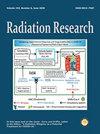胃肠道急性辐射综合征:机理、模型、标记物和医疗对策。
IF 2.5
3区 医学
Q2 BIOLOGY
引用次数: 0
摘要
据报道,由于核电站事故(如切尔诺贝利核电站)、原子弹爆炸(广岛和长崎)以及工业和医疗环境中的事故,人类已多次受到高剂量辐射。如果吸收的辐射剂量足够高,急性辐射综合症(ARS)的演变可能会影响骨髓和胃肠道。胃肠道受损会导致营养吸收不良、脱水、电解质失衡、微生物组和代谢物改变以及屏障功能受损,进而引发败血症和死亡。为了在发生此类事件时做好医疗应对准备,美国国家过敏与传染病研究所(NIAID)资助基础研究和转化研究,以解决辐射诱发的消化道严重急性呼吸系统综合征(GI-ARS),这仍然是一个关键和优先的未满足需求。感兴趣的领域包括确定损害和缓解目标、动物模型开发以及测试医疗对策 (MCM),以解决辐照导致的消化道并发症。为了适当地模拟预期的人体反应,研究临床中与 GI-ARS 类似的疾病状态是很有帮助的,可以为诊断和治疗的最佳实践提供信息,并将其转化为非临床药物疗效模型。出于这些原因,美国国立卫生研究院(NIAID)与另外两个美国政府机构(生物医学高级研究与发展局和食品药品管理局)合作,共同探索模型、生物标志物和诊断方法,以加深对消化道-急性呼吸道综合征复杂性的理解,并研究有前景的治疗方法。2022 年 8 月召开了为期两天的研讨会,来自学术界、工业界、医疗保健界和政府部门的代表在会上做了发言,26 位主题专家在五个科学会议上做了重点发言。本报告概述了会议期间的信息,以及围绕对研究、开发、许可和使用治疗胃肠道综合征的多介质材料至关重要的广泛主题进行的重要讨论。本文章由计算机程序翻译,如有差异,请以英文原文为准。
Gastrointestinal Acute Radiation Syndrome: Mechanisms, Models, Markers, and Medical Countermeasures.
There have been a number of reported human exposures to high dose radiation, resulting from accidents at nuclear power plants (e.g., Chernobyl), atomic bombings (Hiroshima and Nagasaki), and mishaps in industrial and medical settings. If absorbed radiation doses are high enough, evolution of acute radiation syndromes (ARS) will likely impact both the bone marrow as well as the gastrointestinal (GI) tract. Damage incurred in the latter can lead to nutrient malabsorption, dehydration, electrolyte imbalance, altered microbiome and metabolites, and impaired barrier function, which can lead to septicemia and death. To prepare for a medical response should such an incident arise, the National Institute of Allergy and Infectious Diseases (NIAID) funds basic and translational research to address radiation-induced GI-ARS, which remains a critical and prioritized unmet need. Areas of interest include identification of targets for damage and mitigation, animal model development, and testing of medical countermeasures (MCMs) to address GI complications resulting from radiation exposure. To appropriately model expected human responses, it is helpful to study analogous disease states in the clinic that resemble GI-ARS, to inform on best practices for diagnosis and treatment, and translate them back to inform nonclinical drug efficacy models. For these reasons, the NIAID partnered with two other U.S. government agencies (the Biomedical Advanced Research and Development Authority, and the Food and Drug Administration), to explore models, biomarkers, and diagnostics to improve understanding of the complexities of GI-ARS and investigate promising treatment approaches. A two-day workshop was convened in August 2022 that comprised presentations from academia, industry, healthcare, and government, and highlighted talks from 26 subject matter experts across five scientific sessions. This report provides an overview of information that was presented during the conference, and important discussions surrounding a broad range of topics that are critical for the research, development, licensure, and use of MCMs for GI-ARS.
求助全文
通过发布文献求助,成功后即可免费获取论文全文。
去求助
来源期刊

Radiation research
医学-核医学
CiteScore
5.10
自引率
8.80%
发文量
179
审稿时长
1 months
期刊介绍:
Radiation Research publishes original articles dealing with radiation effects and related subjects in the areas of physics, chemistry, biology
and medicine, including epidemiology and translational research. The term radiation is used in its broadest sense and includes specifically
ionizing radiation and ultraviolet, visible and infrared light as well as microwaves, ultrasound and heat. Effects may be physical, chemical or
biological. Related subjects include (but are not limited to) dosimetry methods and instrumentation, isotope techniques and studies with
chemical agents contributing to the understanding of radiation effects.
 求助内容:
求助内容: 应助结果提醒方式:
应助结果提醒方式:


